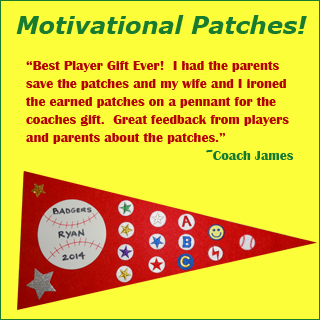Pitching - Pickoff Moves
Be Unpredictable
The key to keeping the opposing team's running game under control is to keep the runners uncomfortable when they are on base. Many pitchers fall into a rhythm and make it easy on the runner to get a good jump. Or they do the same thing each time they are going home and something different when they are making a move. Left-handed pitchers for example, often look at first when they are going home and look at home when they are coming to first. When you are on the mound, do what you can to keep the runner from knowing or having a good guess what you will do on any particular pitch. You can accomplish this by:
- Vary the time you stay set before delivering the ball.
- Step off the mound occasionally.
- Throw over to the base using a variety of speeds. (i.e. You're intention should be not always be showing your best move. Use your best move when you think you have a real chance to pick someone off.)
- Once in awhile, (Not often and only if you think the runner is going to steal and you have thrown over a couple of times) stay in the set position for a long time, until the batter has called time or you count to 7 for example. It's hard to get a good jump when you're sitting still in the leadoff position for a long time.
Runner On First
Right-Handed Pitcher
For the right-handed pitcher, you'll either have to step off the mound and then step and throw to first base or do a quick jump pivot move. The pivot move will be used the majority of the time, but the step off move should be used occasionally, even if you don't always complete it with a throw to first.
Left-Handed Pitcher
The left-handed pitcher has a distinct advantage over a right-handed pitcher on a move to first. You can step off the mound and throw to first, and unlike the right-handed pitcher you can throw to first from your delivery. The key is to appear to the runner as if you are going home, but not stepping too much toward home as to have a balk called by the umpire. As you pick up your leg, you want to make sure you don't cross your leg or foot back over the rubber. This will be called a balk if you attempt to throw to first. It's a good idea to not crossover even when you are throwing home. This will keep the runner from getting a good jump as he will have to wait longer to determine whether you are going home or to first. Try to make your kick the same for both your move and throwing home. When your leg is at the top you will want to drive your shoulder at an angle toward the home plate side of first base. Your leg will come down in the same direction and you can make a quick throw to first.
The step off move also has an advantage over a right-handed pitcher in that you can develop a very quick step off and throw move since you are facing first base.
Runner On Second
Stealing third requires a great jump off the pitcher. Most good base runners look for pitchers that either don't pay much attention to them and/or fall into a certain pattern - come set, one-thousand-one, then deliver. This type of pitcher is inviting the runner to steal and a good baserunner will take advantage.
The good news is that since stealing third requires such a good jump, you as a pitcher can make the runner feel very uneasy at second if you pay attention to him. Besides pickoff or fake pickoff moves, other things you can do to keep the runner uneasy are:
- Vary the time you stay set.
- Look at second as you start your leg kick instead of always looking back towards home before you start your kick.
- Step off the mound occasionally and just hold the ball, looking the runner back.
In addition to those strategies, you can also attempt a pickoff move or fake a pickoff. There are a few methods for making a pickoff move to second. One is to spin towards your glove hand side after you come set, or you can come set and then as you pick up your leg you simply let your leg continue back towards second, planting it and making a throw. Finally, you can step off the mound and then whirl which ever way you are most comfortable with.
Runner On Third
With a runner on third or second and third only, you may prefer to work out of the windup instead of the stretch. Most teams don't attempt to steal home, but if you take a long time delivering to home from the windup, you may want to work from the stretch with a runner on third. No team will attempt a straight steal of home with the pitcher working from the stretch.
Most Recent Blog Posts
Working With Players on Focusing on the Correct Part of the Baseball when Hitting (October 15 2016)
Getting More Accurate Throws From Your Team (April 5 2016)
Coach Edlin,
I am continuously encouraged by your common sense words of wisdom for us dads/coaches who are trying to pave a path of baseball success for our boys.
I catch myself every now and again “over-coaching” my son or other players on the team. I also see a lot of it out there, and it's easy to identify the over-zealous dads to nitpick their kid’s every nuance on the mound or at the plate. By sharing your thoughts, I am given the cerebral reasoning behind what I find distasteful in other dads/coaches... and it reinforces my own goals to avoid that cycle in myself.
Thanks for your efforts. I appreciate it!
- Andrew T.







